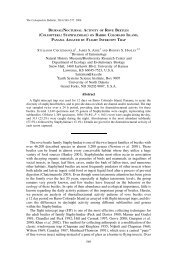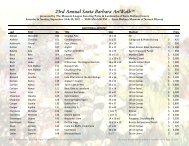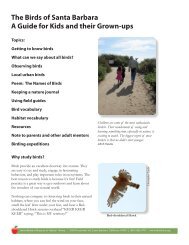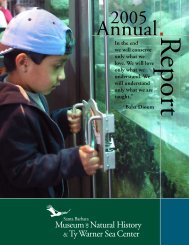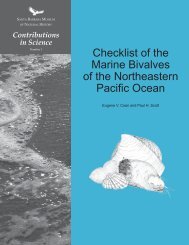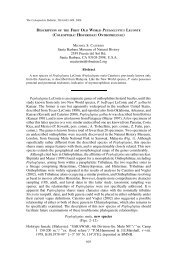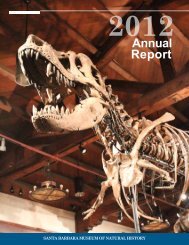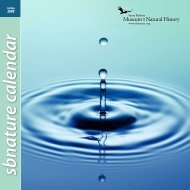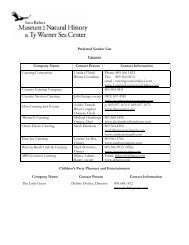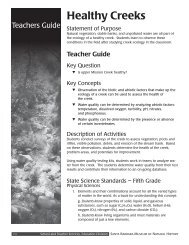three nomenclatural notes on panamic bivalves - Santa Barbara ...
three nomenclatural notes on panamic bivalves - Santa Barbara ...
three nomenclatural notes on panamic bivalves - Santa Barbara ...
You also want an ePaper? Increase the reach of your titles
YUMPU automatically turns print PDFs into web optimized ePapers that Google loves.
Vol. XL(4): 2008 THE FESTIVUS Page 49<br />
THREE NOMENCLATURAL NOTES ON PANAMIC BIVALVES<br />
EUGENE V. COAN & PAUL VALENTICH-SCOTT<br />
<strong>Santa</strong> <strong>Barbara</strong> Museum of Natural History<br />
2559 Puesta del Sol Road, <strong>Santa</strong> <strong>Barbara</strong>, California 93105-2936 U.S.A.<br />
gene.coan@sierraclub.org, pvscott@sbnature2.org<br />
In the process of writing our forthcoming book <strong>on</strong><br />
the bivalve mollusks of tropical western America, we<br />
have encountered a number of <str<strong>on</strong>g>nomenclatural</str<strong>on</strong>g> problems.<br />
We herewith untangle <str<strong>on</strong>g>three</str<strong>on</strong>g> of these issues and illustrate<br />
the species in questi<strong>on</strong>.<br />
I. Pleurolucina undata (Carpenter, 1865) (Figure 1)<br />
This is a case of an improperly renamed junior<br />
hom<strong>on</strong>ym. Hertlein & Str<strong>on</strong>g (1945: 105) renamed<br />
Lucina undata Carpenter, 1865 (p. 279) as Lucina<br />
undatoides, because of “the prior use of that<br />
combinati<strong>on</strong> of names by Lamarck, 1819.”<br />
However, there is no such Lamarckian tax<strong>on</strong>.<br />
Lamarck (1818: 543) had placed Venus undata Pennant,<br />
1777 (plate 58, figure 51), in the genus Lucina. Well<br />
before the era of Hertlein & Str<strong>on</strong>g, this well-known<br />
British species was universally placed in the genus<br />
Mysia Lamarck, 1818: 543, or its junior syn<strong>on</strong>ym<br />
Lucinopsis Forbes & Hanley, 1848: 433, bel<strong>on</strong>ging to<br />
the Veneridae or Petricolidae (for example, Lamy,<br />
1920: 75, 205).<br />
Hertlein & Str<strong>on</strong>g relied in several cases <strong>on</strong><br />
ambiguous entries in nomenclators without researching<br />
the status of the earlier names involved. In this case, as<br />
in some others, they would not have c<strong>on</strong>cluded that the<br />
taxa involved were sec<strong>on</strong>dary hom<strong>on</strong>yms if they had<br />
examined the literature.<br />
Moreover, Hertlein & Str<strong>on</strong>g’s “type” of Lucina<br />
undatoides has no status, even if Carpenter’s name had<br />
been properly replaced. The Hertlein & Str<strong>on</strong>g<br />
replacement name was clearly proposed as such and not<br />
expressly as a new species, thus Carpenter’s type<br />
specimens would also apply to the new name.<br />
Pleurolucina undata (Carpenter, 1865) is <strong>on</strong>e of<br />
<str<strong>on</strong>g>three</str<strong>on</strong>g> Panamic members of this lucinid genus (Figure 1),<br />
<strong>on</strong>e of which is as yet unnamed. It is restricted to the<br />
Golfo de California, México, from the intertidal z<strong>on</strong>e to<br />
60 m depth. Thus, the Hertlein & Str<strong>on</strong>g unnecessary<br />
replacement name becomes a junior syn<strong>on</strong>ym.<br />
II. Sp<strong>on</strong>dylus limbatus G. B. Sowerby II, 1847 (Figure 2)<br />
Sp<strong>on</strong>dylus calcifer Carpenter, 1857 (p. 152), is <strong>on</strong>e<br />
of the most typical Panamic <strong>bivalves</strong>. Indeed, Carpenter<br />
himself extracted many species in his famous Mazatlán<br />
catalogue by breaking up shells of S. calcifer. Found in<br />
and <strong>on</strong> these shells were not <strong>on</strong>ly various borers and<br />
nestlers, but also many gastropods that had taken refuge<br />
in their aband<strong>on</strong>ed burrows and other niches and<br />
crevices. Indeed, he even smashed the type material of<br />
S. calcifer itself in his search (Keen, 1968: 393)!<br />
It thus came as somewhat of a shock to discover this<br />
well-known species placed into syn<strong>on</strong>ymy in a paper<br />
focused chiefly <strong>on</strong> the sp<strong>on</strong>dylids of the eastern Atlantic<br />
(Lamprell et al., 2001:615). As it turns out, Sp<strong>on</strong>dylus<br />
limbatus G. B. Sowerby II, 1847 (1847a: 87; 1847b:<br />
427, plate 88, figure 51), described from the “Persian<br />
Gulf”, was not from there at all, but rather was instead<br />
from the eastern Pacific [BMNH 1846.12.4.1], giving<br />
it a decade’s precedence over S. calcifer.<br />
Unfortunately, the name S. limbatus has been<br />
repeatedly used in the literature, albeit in the wr<strong>on</strong>g<br />
province, so that it is not a nomen oblitum under the<br />
current Internati<strong>on</strong>al Code of Zoological Nomenclature<br />
(ICZN, 1999), so as to trigger its “Reversal of<br />
precedence” provisi<strong>on</strong>s (Article 23.9.1-2), and the name<br />
S. calcifer is not so universally known that we feel it<br />
worthwhile to prepare a petiti<strong>on</strong> to the Internati<strong>on</strong>al<br />
Commissi<strong>on</strong> to c<strong>on</strong>serve it under Article 23.9.3. As a<br />
result, we propose to use the earliest available name for<br />
the species, S. limbatus, for the eastern Pacific species.<br />
The species occurs from Bahía de Choya, S<strong>on</strong>ora,<br />
México, to Caleta Mero, Tumbes, Perú, from the<br />
intertidal z<strong>on</strong>e to 18 m.<br />
III. Chi<strong>on</strong>opsis lilacina (Carpenter, 1864) (Figure 3)<br />
This is another case of a hom<strong>on</strong>ym that never was,<br />
together with the unearthing of some l<strong>on</strong>g-overlooked<br />
type specimens.
Page 50 THE FESTIVUS Vol. XL(4): 2008<br />
A B<br />
C<br />
Figure 1. Pleurolucina undata (Carpenter, 1865), SBMNH 127307, México, Baja California Sur, La Paz, shell length<br />
= 15 mm; A, external right; B, external left; C, internal left; D, internal right.<br />
D
Vol. XL(4): 2008 THE FESTIVUS Page 51<br />
A<br />
C<br />
Figure 2. Sp<strong>on</strong>dylus limbatus G. B. Sowerby II, 1847, SBMNH 138364, México, Baja California Sur, Punta Chivato,<br />
shell length = 77 mm; A, external right; B, internal right; C, external left; D, internal left.<br />
Plate 2<br />
B<br />
D
Page 52 THE FESTIVUS Vol. XL(4): 2008<br />
Carpenter (1864: 570) proposed the name Venus<br />
crenatula lilacina for an eastern Pacific subspecies of<br />
the western Atlantic Venus crenatula G. B. Sowerby II,<br />
1853, ex Chemnitz ms (p. 729, plate 161, figure 190).<br />
The earliest name for the western Atlantic species is<br />
now c<strong>on</strong>sidered to be Venus pubera Bory de Saint<br />
Vincent, 1827, ex Valenciennes ms (p. 152; pl. 267,<br />
fig. 4).<br />
Carpenter’s tax<strong>on</strong> was based <strong>on</strong> an eastern Pacific<br />
lot figured by Reeve (1863: plate 13, figure 46). He<br />
found these specimens differed from West Indian<br />
material in details of sculpture and external markings,<br />
and presumably in terms of its internal lilac blush, hence<br />
the name. Carpenter referred, rather ambiguously, to<br />
additi<strong>on</strong>al material sent by Xantus either to the BMNH<br />
or the USNM. Thus, we herein designate as the<br />
lectotype the specimen illustrated by Reeve (BMNH<br />
20050240-1) (Figure 3).<br />
Dall (1902: 393) then offered Chi<strong>on</strong>e purpurissata<br />
as a replacement name for the eastern Pacific Chi<strong>on</strong>e<br />
lilacina (Carpenter, 1864) <strong>on</strong> the grounds that it was<br />
preoccupied by “Chi<strong>on</strong>e lilacina (Gray, 1838)”.<br />
However, there is no such tax<strong>on</strong>. Gray (1838: 305) had<br />
merely placed Callista lilacina Lamarck, 1818 (pp. 564-<br />
565), in the genus Chi<strong>on</strong>e. Lamarck’s tax<strong>on</strong> is now<br />
regarded as a syn<strong>on</strong>ym of Callista erycina (Linnaeus,<br />
1758) (p. 686, originally described as Venus), a smoothshelled<br />
Indo-Pacific member of the Pitarinae (Habe,<br />
1977: 270; Oliver, 1992: 187). Thus, had he reviewed<br />
the literature, Dall (1902) would certainly not have<br />
regarded these two taxa as bel<strong>on</strong>ging to the same genus.<br />
The eastern Pacific Chi<strong>on</strong>e lilacina occurs from<br />
Bahía de Los Angeles, Baja California, and Puerto<br />
Lobos, S<strong>on</strong>ora, México, to Playas de Villamil, Guayas,<br />
Ecuador, from the intertidal z<strong>on</strong>e to 80 m depth. It<br />
differs from the closely related western Atlantic C.<br />
pubera in being proporti<strong>on</strong>ately higher and in having the<br />
internal lilac blush. Dall’s unnecessary replacement<br />
name should be regarded as a junior syn<strong>on</strong>ym.<br />
Acknowledgments<br />
We are very appreciative for assistance from Dr.<br />
John Taylor (BMNH) in finding the Carpenter type<br />
specimens of Chi<strong>on</strong>opsis lilacina, and Kathie Way and<br />
Amelia MacLellan (both BMNH) for arranging the loan<br />
of these important specimens. Patricia Sadeghian<br />
(SBMNH) photographed the specimens of Pleurolucina<br />
undata and Sp<strong>on</strong>dylus limbatus. We also thank Richard<br />
E. Petit for useful comments <strong>on</strong> the manuscript.<br />
Literature Cited<br />
BORY DE SAINT VINCENT, JEAN BAPTISTE GEORGE MARIE<br />
[BRUGUIÈRE, JEAN GUILLAUME, JEAN BAPTISTE PIERRE<br />
ANTOINE DE MONET DE LAMARCK & JEAN BAPTISTE<br />
GEORGE MARIE BORY DE SAINT-VINCENT]<br />
1791-1827. Tableau encyclopédique et méthodique des trois<br />
règnes de la nature. Vers, coquilles, mollusques, et<br />
polypiers. Paris (Agasse). 3 vols., viii + 180 + 16<br />
pp., 488 pls. [pp. i-viii + 1-83 [84 blank], pls. 1-95,<br />
30 July 1791, Bruguière; 85-132, pls. 96-189, May<br />
1792, Bruguière; pls. 190-286, 8 July 1797, Bruguière;<br />
pls. 287-390, 29 April 1798, Lamarck; pp. 1-16, pls.<br />
391-488, 14 Dec. 1816, Lamarck; pp. 83 [repr.]-84,<br />
133-180, 27 Sept. 1827, Bory de Saint-Vincent)].<br />
CARPENTER, PHILIP PEARSALL<br />
1857. Catalogue of the collecti<strong>on</strong> of Mazatlan shells, in the<br />
British Museum: collected by Frederick Reigen.<br />
L<strong>on</strong>d<strong>on</strong> (British Museum). xii + 552 pp. [some as i-iv<br />
+ ix-xvi] [published simultaneously as "Catalogue of<br />
the Reigen collecti<strong>on</strong> of Mazatlan Mollusca, in the<br />
British Museum." Warringt<strong>on</strong> (Oberlin Press). viii +<br />
xii + 552 pp.] (1 Aug.).<br />
1864. Supplementary report <strong>on</strong> the present state of our<br />
knowledge with regard to the Mollusca of the west<br />
coast of North America. British Associati<strong>on</strong> for the<br />
Advancement of Science, Report 33[for 1863]: 517-686<br />
(post-1 Aug.).<br />
1865. Diagnoses of new species of mollusks, from the west<br />
tropical regi<strong>on</strong> of North America, principally collected<br />
by the Rev. J. Rowell, of San Francisco. Proceedings<br />
of the Zoological Society of L<strong>on</strong>d<strong>on</strong> for 1865(1): 278-<br />
282 (June).<br />
DALL, WILLIAM HEALEY<br />
1902. Synopsis of the family Veneridae and of the North<br />
American Recent species. United States Nati<strong>on</strong>al<br />
Museum, Proceedings 26(1312): 335-412, pls. 12-16<br />
(29 Dec.).<br />
FORBES, EDWARD & SYLVANUS CHARLES THORP HANLEY<br />
1848-1853. A history of British Mollusca, and their shells.<br />
L<strong>on</strong>d<strong>on</strong> (van Voorst). 4 volumes, 2,064 pp., 197 pls.<br />
(1: 433, 1 Nov.).<br />
GRAY, JOHN EDWARD<br />
1838. Catalogue of the species of the genus Cytherea, of<br />
Lamarck, with the descripti<strong>on</strong> of some new genera and<br />
species. The Analyst, a Quarterly Journal of Science,<br />
Literature, Natural History, and the Fine Arts 8(24):<br />
302-309 (post-15 March).<br />
HABE, TADASHIGE<br />
1977. Systematics of Mollusca in Japan. Bivalvia and<br />
Scaphopoda. Tokyo (Zukan-no-Hokuryukan) xiii + 372<br />
pp. + [4] pp. errata, 72 pls. (15 March).<br />
HERTLEIN, LEO GEORGE & ARCHIBALD MCCLURE STRONG<br />
1945. Changes in the nomenclature of two west American<br />
marine bivalve species. The Nautilus 58(3): 105 (19<br />
February).<br />
ICZN [INTERNATIONAL COMMISSION ON ZOOLOGICAL<br />
NOMENCLATURE]<br />
1999. Internati<strong>on</strong>al Code of Zoological Nomenclature. L<strong>on</strong>d<strong>on</strong>,<br />
England (Internati<strong>on</strong>al Trust for Zoological<br />
Nomenclature), xxix + 306 pp.
Vol. XL(4): 2008 THE FESTIVUS Page 53<br />
A B<br />
C D<br />
E<br />
F G<br />
Figure 3. Chi<strong>on</strong>opsis lilacina (Carpenter, 1864), lectotype herein, BMNH 20050240-1, México, Baja California Sur,<br />
Cabo San Lucas, shell length = 66 mm; A, external right; B, external left; C, internal left; D, internal right; E, external<br />
dorsal; F, right hinge; G, left hinge.<br />
Plate 2
Page 54 THE FESTIVUS Vol. XL(4): 2008<br />
KEEN, ANGELINE MYRA<br />
1968. West American mollusk types at the British Museum<br />
(Natural History), IV. Carpenter's Mazatlan collecti<strong>on</strong>.<br />
The Veliger 10(4): 389-439, pls. 55-59 (1 April).<br />
LAMARCK, JEAN BAPTISTE PIERRE ANTOINE DE MONET DE<br />
1818. Histoire naturelle des animaux sans vertébres, ... 5.<br />
Paris (Verdière, Deterville & chez l'auteur), 612 pp.<br />
(25 July).<br />
LAMPRELL, KEVIN LESLIE, JOHN STANISIC & PETER<br />
CLARKSON<br />
2001. Sp<strong>on</strong>dylids from the Mediterranean Sea and Atlantic<br />
Ocean (Mollusca: Bivalvia: Sp<strong>on</strong>dylidae). Queensland<br />
Museum, Memoirs 46(2): 611-622 (30 June).<br />
LAMY, ÉDOUARD<br />
1920-1921. Révisi<strong>on</strong> des Lucinacea vivants du Muséum<br />
d'Histoire Naturelle de Paris. Journal de<br />
C<strong>on</strong>chyliologie 65[(4)19](1): 71-122 (25 July 1920);<br />
(2): 169-222 (20 Nov.); (3): 233-318 (20 June 1921);<br />
(4): 335-388 (20 Oct.).<br />
LINNAEUS, CAROLUS<br />
1758. Systema naturae per regna tria naturae ... editio decima,<br />
reformata, vol. 1 (Regnum animale). Stockholm<br />
(Salvii). 824 + iii pp. (1 Jan.).<br />
OLIVER, P. GRAHAM<br />
1992. Bivalved seashells of the Red Sea. Cardiff, Wales<br />
(Nati<strong>on</strong>al Museum of Wales) & Wiesbaden (Hemmen).<br />
330 pp.<br />
PENNANT, THOMAS<br />
1777. The British zoology, 4th ed., vol. 4: Crustacea.<br />
Mollusca. Testacea. L<strong>on</strong>d<strong>on</strong> (White), 154 + 2 pp., 93<br />
pls. [in <strong>on</strong>e of two versi<strong>on</strong>s published simultaneously].<br />
REEVE, LOVELL AUGUSTUS<br />
1863-1864a. M<strong>on</strong>ograph of the genus Venus. C<strong>on</strong>chologia<br />
ic<strong>on</strong>ica; or, illustrati<strong>on</strong>s of the shells of molluscous<br />
animals 14: 26 pls. (pls. 2-11, April 1863; 12-23, June;<br />
1, Feb. 1864; 24-26, March).<br />
SOWERBY, GEORGE BRETTINGHAM, II<br />
1847a. Descripti<strong>on</strong>s of several new species of Sp<strong>on</strong>dylus.<br />
Proceedings of the Zoological Society of L<strong>on</strong>d<strong>on</strong> for<br />
1847 [15](175): 86-88 (20 July).<br />
1847b. M<strong>on</strong>ograph of the genus Sp<strong>on</strong>dylus. In: G. B. Sowerby<br />
II, ed., Thesaurus c<strong>on</strong>chyliorum; or, m<strong>on</strong>ographs of<br />
genera of shells 1(8): 417-433, pls. 85-89.<br />
1853. M<strong>on</strong>ograph of the genus Venus; supplement; index [to<br />
Veneridae]. In: G. B. Sowerby II, ed., Thesaurus<br />
c<strong>on</strong>chyliorum; or, m<strong>on</strong>ographs of genera of shells<br />
2(14): 703-762, pls. 152-163.



